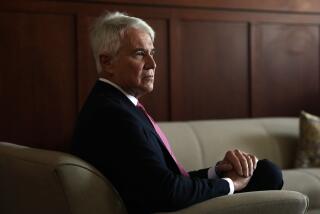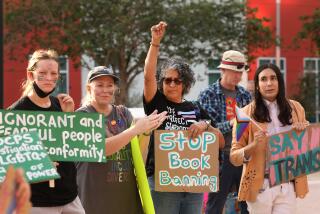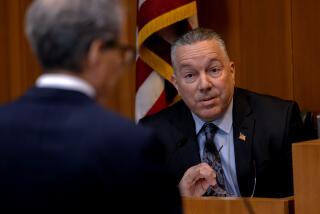Simpson murder case brought change to LAPD, D.A.’s office
In an exchange during the O.J. Simpson murder trial, prosecutor Marcia Clark insisted to Judge Lance Ito that there were no legal precedents to the matter they were discussing.
“So if my Pepperdine law clerks found some …” Ito interrupted.
“Did they? Criminal cases?” asked Clark, caught flat-footed. “And what did they say?”
------------
FOR THE RECORD:
Simpson case: An article in the June 14 Section A about law enforcement changes in the wake of the O.J. Simpson case 20 years ago said Dr. Lakshmanan Sathyavagiswaran stepped down as Los Angeles County’s chief medical examiner and coroner in August. He retired from the post. —
------------
Ito brushed off the experienced prosecutor’s rookie mistake. But nearly 20 years later, this moment survives on YouTube, one of the blunders that continue to be dissected in law school classrooms and prosecution war rooms.
Contrary to expectations, the O.J. Simpson trial didn’t dramatically alter the justice system. No domestic violence legal reforms were passed, and 12 jurors still have to agree in criminal trials in most states, including California.
But the legal pratfalls in the Simpson case helped modernize L.A. County’s’ criminal justice infrastructure and offered some pointed lessons for prosecutors, police, criminalists and judges.
“It was a prosecution loss of biblical proportions, and our office used it as a case study of how to handle high-profile cases,” said former Dist. Atty. Steve Cooley.
For police, the case exposed weaknesses in the way it handled and processed evidence, prompting new procedures and huge investments in cutting-edge crime labs.
“It was an eye-opener for us in a lot of different ways,” said Los Angeles police Cmdr. Andrew Smith.
The perceived mistakes began almost immediately with the decision by then-Dist. Atty. Gil Garcetti — or by Los Angeles County Superior Court judges, as some claim — to try the case in downtown Los Angeles.
Some observers maintained that a jury with a number of African Americans, as was likely downtown at that time, would be less willing to find Simpson guilty than one on the Westside. The June 1994, slayings of Nicole Brown Simpson and Ronald Lyle Goldman occurred at her Brentwood condominium, and the potential jury pool at the nearer Santa Monica courthouse would probably have included more whites.
Veteran prosecutors said they don’t think the jury’s racial makeup made a difference. But Cooley set a policy of trying cases in the closest courthouses.
“What was seen to happen in the O.J. Simpson case was you had people sitting in judgment who had no connection to the Westside,” said Alan Jackson.
Jackson prosecuted music producer Phil Spector, whose 2009 conviction in a retrial ended a string of high-profile defeats for the D.A., including the Rodney King beating prosecution and the Simpson and Robert Blake murder cases.
Said Cooley: “Cases should be filed in the victimized communities.”
Cooley said he also tightened oversight for trial deputies, instituted media training, made better use of the grand jury and brought in focus groups to improve jury selection.
The prosecution’s most spectacular foul-up, many believe, was having Simpson try on the ill-fitting bloody glove found at his Rockingham Avenue estate.
“You can bet all my students know you don’t try on gloves if you don’t know what will happen,” said Loyola Law School professor Laurie Levenson, a frequent trial commentator.
Jackson said having multiple prosecutors present the case might have harmed the case.
For the Spector trial, the D.A. had two lawyers at the prosecution table — “two people sitting at the table with a yellow pad and pencil, approaching the case in a workmanlike fashion,” Jackson said.
“The tag-team approach was a very poor prosecution technique,” Cooley said.
Simpson’s defense theme was that evidence had been contaminated by sloppy collection and handling.
LAPD Det. Tom Lange testified he left a pair of Simpson’s shoes in his car trunk overnight; criminalist Dennis Fung said he reluctantly carried the bloody glove from Simpson’s home to the crime scene at Lange’s direction. Lange also said there was a seven-hour delay in calling the coroner to the scene after detectives found the bodies.
Doreen Hudson, director of the LAPD criminalistics laboratory, said the collection was handled correctly and the evidence was not corrupted, but she added that the case put “forensic science into everybody’s living room.”
Today, separate teams of criminalists would probably be sent to process the three crime scenes — the Bundy Drive condominium, Simpson’s white Bronco and his Rockingham home — under the supervision of a veteran manager, Hudson said.
Lakshmanan Sathyavagiswaran, who stepped down as Los Angeles County’s chief medical examiner and coroner last August, said the Simpson case prodded the Legislature to fund the county’s $102-million regional crime lab, which opened in 2007.
In the Michael Jackson and Whitney Houston deaths, “we handled the cases in a more professional manner because of better staffing and better labs,” Sathyavagiswaran said.
Said Smith, the LAPD commander: “I think a lot more carefully about how we preserve things for the criminalists that are going to come, and for the detectives.”
The prosecution’s DNA evidence was supposed to cancel out the collection testimony and bowl jurors over, but after weeks of scientific testimony some were caught nodding off.
Jackson said the D.A. no longer puts on “mind-numbing” displays of DNA science for jurors.
“I tell everyone I train, doesn’t make a difference if you are a rocket scientist if you can’t make the average person understand what you do,” said Donna Brandelli, a former forensics specialist with the L.A. County Sheriff’s Department and the city of Torrance.
After the verdict, Ito was castigated for failing to rein in lawyers and for presiding with one eye on the cameras.
“He would have celebrities in his chambers, and that didn’t look good,” said veteran defense attorney Harland Braun.
Ito wasn’t the only person in the courtroom who seemed star-struck.
“We had witnesses who had no business testifying showing up with one eye on the cameras and witnesses who had important evidence not showing up because they didn’t want to be involved,” said Daniel Petrocelli, who tried the civil case that found Simpson responsible for the deaths of his ex-wife and Goldman.
More recently, judges in the Spector and Conrad Murray cases ruled with an iron hand, prosecutors said, and the D.A. worked to take the celebrity out of justice.
“We treated high-profile trials as we would any other serious criminal case,” said Pat Dixon, a former assistant district attorney.
Asked to comment, Ito said in an email Friday that ethics rules “restrain me from responding” because the Simpson case “is still a pending collection matter,” a reference to the Goldman family’s ongoing efforts to collect damages from the civil case.
Braun and Harvard Law School professor Charles Ogletree Jr. said Ito was unfairly blamed for an unpopular verdict.
Ogletree said the Simpson case transformed how he teaches law; students who weren’t even born when the verdict came down are intrigued by the case.
“They are mesmerized by it,” Ogletree said.
More to Read
Sign up for Essential California
The most important California stories and recommendations in your inbox every morning.
You may occasionally receive promotional content from the Los Angeles Times.












